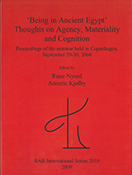Rune NyordAssociate Professor
Education
- Ph.D., University of Copenhagen, 2010
Biography
Rune Nyord is Associate Professor of Ancient Egyptian Art and Archaeology at Emory University. Before joining Emory in 2018, he held positions at the University of Copenhagen, University of Cambridge (Christ's College), and the Free University Berlin. His research focuses on conceptions and experiences of representation, ontology, and personhood in ancient Egypt, especially as evidenced in Middle Kingdom (Middle Bronze Age, early 2nd millennium BCE) funerary culture, and drawing on a combination of archaeological and textual sources. He is also interested in the history of the discipline of Egyptology and ways in which it continues to influence contemporary practices and interpretations.
Research Interests
- Ancient Egyptian mortuary religion and funerary culture
- Ancient Egyptian conceptions and experiences of images, conceptions of personhood and the body
- Anthropological and cognitive approaches to ancient material culture and texts
- History of Egyptology, especially the history of interpretations of Egyptian religion
Selected Publications
Books
 | Yearning for Immortality: The European Invention of the Ancient Egyptian Afterlife (Chicago: University of Chicago Press, 2025) |
 | Seeing Perfection: Ancient Egyptian Images beyond Representation (Cambridge: Cambridge University Press, 2020) |
 | Breathing Flesh: Conceptions of the Body in the Ancient Egyptian Coffin Texts (Copenhagen: Museum Tusculanum Press, CNI Publications no. 37, 2009) |
Edited Volumes
Recent Articles and Book Chapters
"Manifesting powers: Masks and masking in the Middle Kingdom," in Under the Spell of Bes, eds. B.F. van Oppen de Ruiter and R.S. Bianchi (Wallasey: Abercromby Press, 2024), pp. 67-85
"Bodies of stone and wood in ancient Egypt," in Living Bodies, Dead Bodies, and the Cosmos: Culturally Specific and Universal Concepts, eds. C. Ferella, T. Pommerening, and U. Steinert (Tübingen: Mohr Siebeck, 2024), pp. 67-90
"Ansigt til ansigt med guderne: Rituelle masker i det gamie Ægypten [Face to face with the gods: ritual masks in ancient Egypt]," Papyrus: Ægyptologisk tidsskrift 44, no. 1 (2024): 18-27
“Like birds of passage," in Ancient Egypt: Obsessed with Life, ed. O. Herslund (Aarhus: Moesgaard Museum, 2023), pp. 62-75
"The good burial," in Life and the Afterlife: Ancient Egyptian Art from the Sunusret Collection, ed. M. Hartwig (Atlanta: Michael C. Carlos Museum, 2023), pp. 31-34
"Ancient Egypt," in Comparative Guts (online exhibition), eds. C. Thumiger and A. Messner (Kiel: University of Kiel, 2023)
"From Crypt to Cult: Pyramid Texts on Middle Kingdom Stelae," Studien zur Altägyptischen Kultur 51 (2022): pp. 191-204
"The Letter to Nebetitef on her First Intermediate Period Stela in the Michael C. Carlos Museum," Journal of Egyptian Archaeology 107 (2021): pp. 3-19
"Motile mythologies. (Re)constituting ancient Egyptian ritual knowledge in the early 2nd millennium BCE," in Wissensoikonomien: Ordnung und Transgression in vormodernen Kulturen, eds. G. Ullmann, N. Pissis, and N. Schmidt (Wiesbaden: Harrassowitz, 2021), pp. 199-210
"Post til en afdød: Nebetitefs genfundne brev [Mail for a deceased person: The rediscovered letter to Nebetitef]," Papyrus: Ægyptologisk Tidsskrift 41, no. 1 (2021): 22-29
(older works available on academia.edu and researchgate.net)
Current Projects
Rune Nyord's current book project concerns new ways of reading and viewing the ancient Egyptian "Book of the Dead," or Recitations for Coming Forth by Day. This composition has become known to scholars and the public alike as a detailed guidebook to what the ancient Egyptians thought happened in the afterlife. In recent years there has been a growing realization that perhaps that understanding is a little too convenient to be realistic: Did the ancient Egyptians really set out to answer the main question on modern scholars' minds in a descriptive and literal fashion? Or have we been missing significant parts of the cultural context of this work in making it speak so unequivocally to modern concerns? The book sets out to explore the implications of this idea, aiming to understand the work in new ways by prioritizing its indigenous social and conceptual contexts over traditional explanatory strategies.
In particular, the work's use of images can be rethought, whereby its visual component (often dealt with rather cursorily in existing scholarship) gains new importance. Building on the earlier monograph Seeing Perfection: Ancient Egyptian Images beyond Representation (Cambridge, 2020), the "vignettes" of the Coming Forth by Day are understood according to indigenous terminology as configurations (sšmw) of individual figures (twtw) which serve actively to establish and maintain the social and cosmic relations depicted—in contrast to the modern gaze that has tended to understand them as meant to convey information about the afterlife. As with the parallel case of the recitation texts, this makes the picture amenable to comparison with other ritual uses of images in ancient Egypt, rather than forming part of a special genre of "funerary literature."




